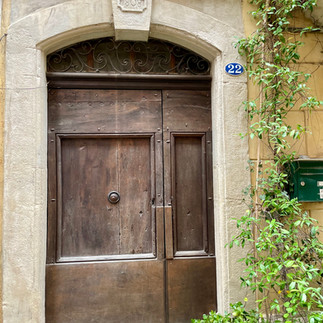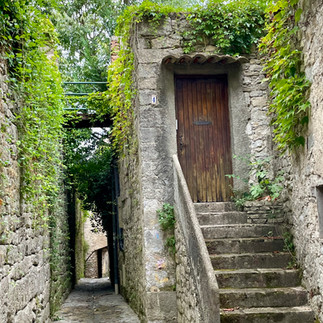Drive a short distance down the road from my little town, St. Hippolyte du Fort, and you'll find this charming scene:

Welcome to Sauve, with its rich history dating back to the 11th century.
Come, wander with me across the river, through narrow cobbled streets, under stone arches, and past ancient buildings. If only these walls could talk!

We enter the village by Le Pont Vieux, the Old Bridge, built between the 11th and 13th centuries. These dates cause my American head to spin. People, no different from us, lived out their lives in such little towns—raising families, figuring out ways to feed themselves, fighting off enemies. I'd love to (temporarily) transport back to such a time and observe it all.
Let's take a moment to savor this lovely view from the bridge before we enter the village.

Back in the day, the entry arch guarded the entrance to the village and included an iron gate to keep out enemies. Inside, the tiny street curves sharply left, another device to slow down intruders.
I have a funny story about this passage. Years ago, when we first moved to St. Hippolyte du Fort, I brought visiting friends to Sauve. I'd not yet been there, but we hoped to find a restaurant open on a Monday night in the off-season. Not knowing how tiny the streets were, we drove through the village looking for a place to eat. Unfortunately, we came upon this tight turn from the inside. After many attempts, with neighbors looking out windows and shaking their heads, we gave up and painstakingly backed out the long narrow street. My friends were incredibly gracious about the whole thing and, thankfully, their rental car came out unscathed. Oh, and we ended up at a wonderful restaurant, that is still one of our favorites.
Today, we are welcome to enter and soak in history. On foot!

Once inside the village, we continue on through streets filled with homes, artists' workshops and ruins. It's fascinating to observe the juxtaposition of ancient and modern.


You'll find a small drain like this in most medieval towns. Originally used for the emptying of chamber pots—often thrown from upper windows—filling the streets with running sewage. I can hardly imagine the odor and the ever-present germs.
As seen by the street sign in the above photo, Rue du Roi, King Street, Sauve has a royal past. Medieval kings passed through and often stayed the night. Prominent and powerful noble families dwelled here as well, until one sided with the ill-fated Cathar sect, which was wiped out by the French king in the 13th century. Ruins of the nobles' medieval château spread across the mountain crest above the village.

Arches abound in Sauve. Here are a few:





As we climb the hill, rising above the village, signs appear for La Mer des Rochers, The Sea of Rocks. Let's go see!

On the way, we see the ruins of the original chateau and fortifications.


A little humor here: "The Sea. Swimming authorized."

And voilà! The Sea of Rocks. If only they could tell all the stories!

Here's another view, taken on a different day:

As we wind our way back down the mountain and in to the village, we discover seeping views and more charming old, old homes. Who lived there? What did they do high on this hill? Were they servants and workers for the nobles?



Farther down on the left, we discover the ruins of an 18th century Capucine convent. So much went on in this relatively small town.
Back in the village, we walk past the ancient Bishop's home, with rap music blaring from an adjacent apartment. I wonder what the bishop would've thought.

It's a little hard to see, but there's a relief of a bishop's mitre over the door.
Speaking of doors, here are some of my favorites:
I appreciate the effort put into this relief work depicting the history of Sauve. Wow!

We continue on through an arched passageway, once lined with the workshops of various wood artisans, and arrive in the pleasant central square.



In the medieval period, this area housed a Benedictine abbey and a cemetery. During a time of peace in the wars of religion, a Protestant church existed in this location. Authorities demolished it when Louis XIV rendered Protestantism illegal. Today, we have cafés, restaurants, the town hall, and more sweeping views.

Hotel de Ville, the Town Hall
Quite grand for a small village. I believe this attests to the noble past. The Catholic church is around the corner, and a Protestant temple farther on.
I'd love to know more about this magnificent house. So many interesting features. Is it privately owned? Rental apartments inside? I couldn't find anything online about it.

We'll exit the village across the Pont Neuve or New Bridge, seen just beyond the beautiful garden in the above photo. During the Huguenot uprising (Camisard War) of the early 18th century, Louis XIV's regional governor ordered a wider bridge built across the river to accommodate the transport of materials and royal troops. This Governor Bâville added more fortification to the town as well. You can meet him in my novel, The Light Shines Through, and read about a clever deception by the Camisards and a subsequent battle in Sauve with royal soldiers, all based on actual events.

View from Pont Neuve, the New Bridge
Au revoir, Sauve!
La vie est belle...























Comments